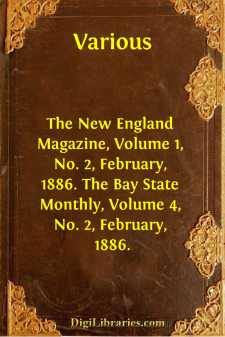Categories
- Antiques & Collectibles 13
- Architecture 36
- Art 48
- Bibles 22
- Biography & Autobiography 813
- Body, Mind & Spirit 142
- Business & Economics 28
- Children's Books 15
- Children's Fiction 12
- Computers 4
- Cooking 94
- Crafts & Hobbies 4
- Drama 346
- Education 46
- Family & Relationships 57
- Fiction 11829
- Games 19
- Gardening 17
- Health & Fitness 34
- History 1377
- House & Home 1
- Humor 147
- Juvenile Fiction 1873
- Juvenile Nonfiction 202
- Language Arts & Disciplines 88
- Law 16
- Literary Collections 686
- Literary Criticism 179
- Mathematics 13
- Medical 41
- Music 40
- Nature 179
- Non-Classifiable 1768
- Performing Arts 7
- Periodicals 1453
- Philosophy 64
- Photography 2
- Poetry 896
- Political Science 203
- Psychology 42
- Reference 154
- Religion 513
- Science 126
- Self-Help 84
- Social Science 81
- Sports & Recreation 34
- Study Aids 3
- Technology & Engineering 59
- Transportation 23
- Travel 463
- True Crime 29
The New England Magazine, Volume 1, No. 2, February, 1886. The Bay State Monthly, Volume 4, No. 2, February, 1886.
by: Various
Categories:
Description:
Excerpt
Tufts College is situated on the most beautiful and commanding eminence in the southeasterly part of Middlesex county, within the town of Medford and on the borders of Somerville. This eminence was formerly called Walnut Hill, on account, it is said, of the heavy growth of hickory timber with which it was covered at the time of the settlement of the colony, but is now called College Hill, on account of the institution which crowns it. The land on which the College is built is a part of the farm which the late Charles Tufts received by way of inheritance; and, when asked by his relatives what he would do with the bleak hill over in Medford, he replied, "I will put a light on it." The tract of land originally given by Mr. Tufts consisted of twenty acres. Subsequently he gave his pledge to add other valuable tracts adjoining. This pledge has been fulfilled, so that the plot of ground, belonging to the College, given by Mr. Tufts, embraces upwards of one hundred acres. The late Deacon Timothy Cotting, of Medford, also gave to the College at his decease, a piece of land lying near the institution containing upwards of twenty acres. In consequence of the munificence of Mr. Tufts, it was determined that the College should bear his name.
President Capen.The definite impulse which resulted in the establishment of Tufts College may be traced to the sermon preached by Hosea Ballou, 2d., D.D., before the General Convention of Universalists, in the city of New York, September 15, 1847. In this sermon Dr. Ballou urged the "duty of general culture" and the importance that a denomination should have "at least one college placed on a permanent basis," with such clearness and emphasis that the movement at once took organic shape and went forward without pause from that hour. Dr. Ballou declared that one hundred thousand dollars was the least sum with which the work could begin and have any prospect of success. The Rev. Otis A. Skinner was appointed to obtain subscriptions to a fund to that amount. The sum was a large one in the then condition of the Universalist body. But in an undertaking of that kind, Mr. Skinner knew no such word as fail. It took years for the accomplishment of his task; but in the summer of 1851 he was able to announce that the subscription was completed. A meeting of the subscribers was held in Boston on the sixteenth and seventeenth of September of that year. A board of trustees was designated who subsequently fixed upon the present site of the institution and determined its name. Application was made to the Legislature for a charter, which was granted April 21, 1852. The original charter conferred the power to grant every kind of degree usually given by colleges, "except medical degrees." This restriction was removed by act of the Legislature, dated February 2, 1867.
COLLEGE CHAPEL.In July, 1852, the Rev. Thomas J. Sawyer, D.D., was elected president of the College. But he declined to accept the office on the terms prescribed, and in May, 1853, the Rev. Hosea Ballou, 2d, D.D., was chosen to the office, which he filled until his death in May, 1861. In July following his election the corner-stone of the main College hall was laid by Dr. Ballou. The event was one of great interest and significance, and drew together a large company of people from different sections of the country. A year was spent by the president in visiting the most prominent institutions of learning at home and abroad, preparatory to organizing the new College, and laying out its course of study. In the work of organization, Dr. Ballou received important and valuable assistance from John P. Marshall, the present senior professor and dean of the College of letters. The College was first regularly opened for the admission of students in August, 1855, though a few students had been residing at the College and receiving instruction from the president and Professor Marshall during the previous year. In the beginning the success of the institution was as marked as its friends could reasonably expect. But the great anxiety attending the beginning and development of so important an undertaking seriously affected the health of Dr. Ballou, and he was cut down before the College could avail itself of the transcendent abilities which he brought to the discharge of his duties, and before he could witness the almost unexampled material prosperity awaiting it....












